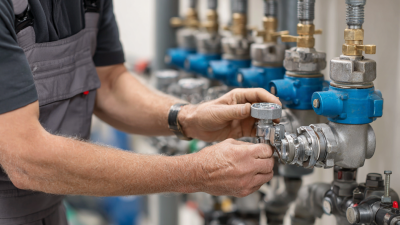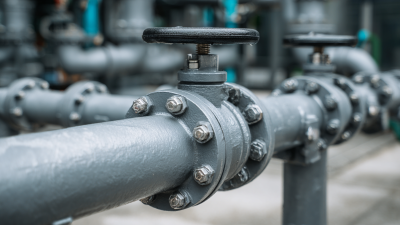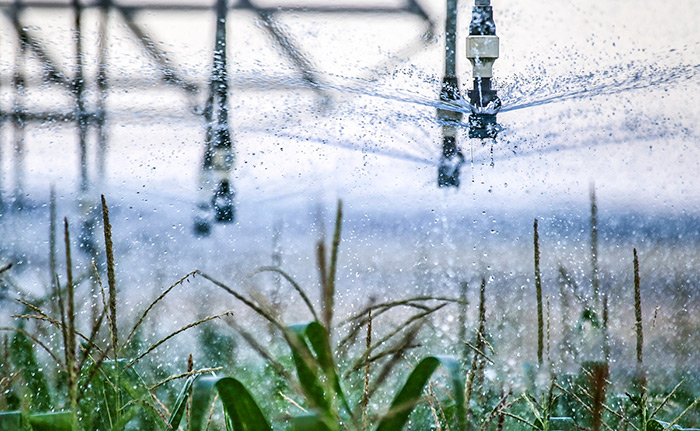The Ultimate Guide to PVC Butterfly Valves: Revolutionary Solutions for Fluid Control
Table of Contents
- Understanding PVC Butterfly Valves: Key Features and Benefits
- Top 5 Advantages of Using PVC Butterfly Valves in Fluid Control
- How to Choose the Best PVC Butterfly Valve for Your Application
- Maintenance Tips for Optimal Performance of PVC Butterfly Valves
- Innovative Applications of PVC Butterfly Valves in Various Industries
- Exploring the Efficiency and Durability of PVC Butterfly Valves with Gear Handles: Insights from Recent Industry Reports
- FAQS
- Conclusion
- Related Posts
These days, as fluid control technology keeps evolving, PVC butterfly valves are really making a splash. They've become a pretty popular choice, thanks to their innovative design and efficiency. Honestly, they're great at smoothly controlling flow, and you’ll find them popping up in all sorts of industries—whether it’s water treatment, chemical processing, or other sectors. Here at Ningbo Pntek Technology Co., Ltd., we're proud to be a reliable supplier of plastic pipes, fittings, and valves. With more than 10 years of experience exporting our products worldwide, we focus a lot on quality and making sure our customers are happy. That’s why we're considered one of the top sources for PVC butterfly valves—designed to meet the different needs of our clients. This guide is all about walking you through how these valves work, their benefits, and where they’re used. Plus, we’ll share a bit about our expertise in providing top-notch solutions to improve fluid control systems across various industries.

Understanding PVC Butterfly Valves: Key Features and Benefits
PVC butterfly valves are pretty important when it comes to controlling fluids — they’re used in a lot of different setups, and for good reason. Basically, they have a disc inside that spins to open or close the flow, giving you pretty precise control over liquids and gases moving through a pipe. One of the biggest perks? They’re lightweight, which makes installing and maintaining them way easier than those old-school metal valves. Plus, since PVC resists corrosion really well, these valves can handle all kinds of nasty chemicals. That’s why you’ll often see them used in water treatment plants, farms, or chemical plants.
And let’s not forget—PVC butterfly valves are pretty budget-friendly. They don’t need a lot of power to operate because of their smart design, which means less pressure loss and lower energy bills in the long run. They’re also simple enough that the chances of something breaking down are pretty slim, so you get more reliable performance and less downtime. All in all, these valves combine practicality with solid performance — they’re honestly a game-changer for controlling fluids in all sorts of industries and situations.

Top 5 Advantages of Using PVC Butterfly Valves in Fluid Control
When it comes to controlling fluids, PVC butterfly valves have really become a game-changer in a bunch of different industries. One thing folks love about these valves is how lightweight they are. I read somewhere that the valve market is expected to hit around $81.3 billion by 2025—thanks, in part, to the rising need for lighter materials that make installation and handling much easier.
 PVC butterfly valves are way lighter than traditional metal ones, which makes them perfect for hanging setups or places where you need to do maintenance pretty often.
PVC butterfly valves are way lighter than traditional metal ones, which makes them perfect for hanging setups or places where you need to do maintenance pretty often.
Another big plus is how resistant they are to corrosion. These valves can handle aggressive chemicals and tough environments without really taking a hit. A survey published in the Chemical Engineering Journal even reported that companies using PVC butterfly valves saw maintenance costs drop by about 30%. That’s mainly because they don’t need to replace the valves as often. Plus, they seal tightly and control flow really well, which means things run smoother and more efficiently. Better flow control means energy savings too, so honestly, choosing PVC butterfly valves isn’t just practical — it’s a smart move for keeping fluid systems running smoothly and saving money in the long run.
How to Choose the Best PVC Butterfly Valve for Your Application
When you're trying to pick the best PVC butterfly valve for your setup, there are a few key things you really should keep in mind. These valves are pretty popular because they’re lightweight and resist corrosion—perfect for all sorts of fluid control jobs, like water supply, drainage, or even in industrial settings.
Oh, and by the way, a report from MarketsandMarkets actually predicts that the PVC pipe and fittings market could hit around $66.87 billion by 2030. That just shows how much demand there is for reliable fluid control options these days.
Here’s a tip: Make sure to check the pressure ratings and the size of the valve to match your system. Picking the right size isn’t just about fitting—it helps maintain good flow and keeps your plumbing from getting overworked, ya know?
Also, when you’re shopping around, don’t forget to consider whether the valve is compatible with the chemicals or fluids you'll be using. This can make a big difference in how long the valve lasts and how well it does its job. Given how fast the PVC market is growing—it's expected to grow at about 6.7% annually—taking the time to pick the right materials and specs is super important. It’ll pay off in the long run, making sure your systems stay safe and efficient.
And hey, if you’re not totally sure about the right choice, it’s always a good idea to chat with a specialist. Especially if your application involves more demanding conditions—you want to be confident that your valve meets all the industry standards and regulations.
Maintenance Tips for Optimal Performance of PVC Butterfly Valves
Taking good care of PVC butterfly valves is super important if you want them to perform well, especially in industries where controlling fluids is a big deal. It’s a good idea to check them regularly for any signs of wear — things like leaks or buildup of residue, which can mess with how they work. Giving the valves a good clean and making sure the seals are in good shape are pretty simple but crucial steps to keep everything running smoothly. After all, these valves do a big job in managing the flow of liquids across different setups.
On top of that, staying in the loop with the latest industry trends can really help extend the life of your valves and keep them working efficiently. The global market for control valves is booming, so having up-to-date knowledge about new tech and best practices can make a real difference. It’s all about being proactive — not just sticking to a maintenance schedule, but also being ready to adapt to new methods that are better for the environment and boost efficiency. At the end of the day, paying attention to these things can lead to less downtime and better overall performance for your fluid systems.
Innovative Applications of PVC Butterfly Valves in Various Industries
When it comes to controlling fluids, PVC butterfly valves are really starting to make waves across a bunch of different industries. People are noticing their clever applications and how efficiently they work. Lately, industry reports have been pointing out that the market for PVC valves—including these butterfly kinds—is expected to grow quite a bit. That’s mostly because they’re affordable, lightweight, and resistant to corrosion. These features make them a popular choice for stuff like water treatment plants, chemical processing, and HVAC systems.
What’s cool is how versatile PVC butterfly valves are—they actually do well in a variety of settings. Take the municipal firefighting scene, for example: these valves can help control water flow quickly and effectively, which is super handy during emergencies. Plus, as manufacturing keeps growing, the demand for these valves is likely to increase too. Experts are estimating a compound annual growth rate of about 5.2% in the valve market by 2032. All in all, it looks like PVC butterfly valves are poised to keep playing a key role in making fluid management more efficient across many sectors.
Exploring the Efficiency and Durability of PVC Butterfly Valves with Gear Handles: Insights from Recent Industry Reports
Recent industry reports emphasize the efficiency and durability of PVC butterfly valves equipped with gear handles, making them a popular choice in various applications. These valves integrate advanced design features that enhance their functionality, primarily through the choice of materials used in their construction. The body of the valve is typically made from UPVC, CPVC, or PPG, which not only ensures a lighter design but also offers excellent resistance to corrosion and chemical exposure.
The internal components, such as the seat seal and O-ring made from EPDM or FPM (NBR), provide robust sealing capabilities, preventing leaks and enhancing reliability over time. Additionally, the valve's disc, also constructed from UPVC, CPVC, or PPG, maintains optimal flow characteristics and minimizes pressure drop. The durability of these components is further supported by the use of high-strength materials for the stem and bolts, including SUS304 stainless steel, which contributes to the overall longevity and performance of the valve in demanding operational environments.
The inclusion of a gear box made from iron allows for easy operation, facilitating precise control over the valve's opening and closing functions. This feature significantly enhances the user experience, especially in installations where manual operation might be challenging. As industries increasingly prioritize efficiency and durability in their valve selections, PVC butterfly valves with gear handles present a compelling option that meets these important criteria.
FAQS
: PVC butterfly valves are primarily used for fluid control applications, including water supply, drainage systems, and industrial processes, due to their lightweight and corrosion-resistant properties.
Assessing the pressure rating and size is essential to ensure the valve meets system requirements, allowing for optimal flow rates and preventing unnecessary strain on the plumbing infrastructure.
The compatibility of the valve with specific chemicals or fluids can significantly affect its durability and effectiveness, impacting its performance in regulating those fluids.
The PVC market is expected to witness growth due to increasing demand for reliable fluid control solutions, projected to reach $66.87 billion by 2030 with a CAGR of 6.7%.
Regular inspections for wear and tear, cleaning the valve, and ensuring that seals are intact are critical maintenance practices to ensure optimal performance.
Staying informed about industry trends can enhance the longevity and effectiveness of PVC butterfly valves and contribute to better maintenance strategies amidst the growing demand for efficient fluid control solutions.
Regular inspections should be conducted, although specific frequency will depend on the application and operational conditions, to check for signs of wear and tear such as leaks or residue accumulation.
Understanding advancements in valve technology can lead to improved maintenance practices, reducing downtime and enhancing performance in fluid management systems.
Yes, consulting with a specialist is advisable to ensure that the selected valve meets industry standards and regulations, especially for more demanding applications.
Proactive maintenance not only improves the efficiency of PVC butterfly valves but also promotes sustainability and operational excellence in fluid control applications.
Conclusion
PVC butterfly valves are pretty much essential when it comes to controlling fluids in different systems. They’re lightweight, resist corrosion, and are super easy to install—so they’re a real go-to in many setups. What’s cool is that they come with a bunch of perks: they don’t need much upkeep, you can regulate flow pretty efficiently, and they can handle all sorts of fluids. Of course, picking the right one means thinking about things like size, pressure capacity, and what exactly you need it to do.
Make sure you don’t forget regular maintenance too—stuff like inspections and giving them a quick clean can make a big difference and keep things running smoothly. Lately, folks are finding all kinds of new ways to use PVC butterfly valves across different industries, which just goes to show how versatile and effective they are for keeping operations running well. If you’re looking for a trusted supplier, Ningbo Pntek Technology Co., Ltd. has got you covered. With over ten years of exporting experience, they’re ready to provide top-quality valves tailored to what you need.
Related Posts
-

Why Investing in Pvc Valve Socket Ends Can Enhance Your Pipeline Efficiency by 30 Percent
-

Mastering Fluid Control with Reliable 2 Inch PVC Valves: Your Ultimate Guide
-

Maximize Efficiency: Discover the Innovative Benefits of PVC T Valves in Modern Piping Systems
-

Understanding PVC Valve Socket Sizes: Impact on Flow Rates and System Efficiency in Plumbing
-

How to Choose the Right 1 Inch PVC Valves for Your Plumbing Needs
-

7 Essential Tips for Choosing the Best 6 PVC Ball Valves for Your Projects

Isabelle
Application

Underground pipeline

Irrigation System

Water Supply System


